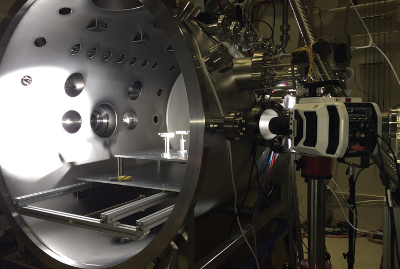Featured Article

While Vision Research Phantom VEO-L camera models are designed specifically for the lab environment, Toni Lucatorto, VEO product manager, notes that with complementary metal-oxide semiconductor (CMOS) cameras, there are almost always trade-offs in resolution, frame rate and light sensitivity.
The company’s highest frame rate camera, the Phantom V2512, offers 25-gigapixel throughput (throughput is the amount of data that can be collected and stored per second), with 1-megapixel resolution. According to Lucatorto, “In spray dynamics, particle research, you need a really high frame rate. However, for smaller particles, a camera with higher resolution is needed, which in the VEO line is the 640 model (6-megapixel throughput, 4-megapixel resolution).”
 Lasers are often used to confirm camera signals for customers’ applications.
Lasers are often used to confirm camera signals for customers’ applications.The V2512 is a large camera; because its sensor runs more channels, more back end and higher memory are needed. The higher the frame rate the camera is recording, the shorter the available recording time. Says Lucatorto, “With a 72-gigabyte camera, you only get a couple of seconds of recording time out of that at 25,000 frames per second. At lower frame rates recording time is increased.” The higher the throughput number, the higher the transfer from the sensor to the rest of the camera.
How do you know what camera is right for your application? A salesperson should be able to help document experimental needs and appropriate equipment. There are online manuals and videos too. Application engineers are available at Vision Research, and training programs can be provided, either at the company offices or on site. All of these resources are further available for reference once equipment is installed.
For microscopic applications, the lens mount connects the camera to a microscope for that particular use. In some instances, an image intensifier is coupled to the camera, sometimes right to the sensor, to intensify a very low-light subject (some subjects are light sensitive). Vision Research offers four different lens mounts on cameras, along with a full range of optical devices.
 Photograph shows testing the effects of microscopic, highly accelerated dust particles on satellites and spacecraft.
Photograph shows testing the effects of microscopic, highly accelerated dust particles on satellites and spacecraft.Speaking of light-sensitive subjects, proper illumination is an important part of image capture. Lucatorto says that, “Traditional lighting is not always best for the subject. Make sure that there is enough light and proper lighting technique.” She also noted that backlights are very useful in biological imaging, and that there are high-quality LED backlights available. Choosing the correct type of light for the subject and circumstances will ensure the resulting images look good and provide appropriate detail.
For motion analysis, data transfer is a critical function. At high frame rates, camera memory is filled quickly and it will be necessary to capture the data and output it quickly. For example, Vision Research has cameras that can offload more than 100 gigabytes of raw data in just over a minute so that shooting can continue.
Vision Research is a business unit of the Materials Analysis Division of AMETEK Inc., a leading global manufacturer of electronic instruments and electromechanical devices.
